2. 贵州大学理学院, 贵阳 550025
2. College of Science of Guizhou University, Guiyang 550025, China
衰减(Q-1)是描述岩石粘弹性的一个重要参量,研究衰减可以了解岩石的微构造及变化、岩石在地下所遇到的环境条件(徐彦等,2004;陈颙等,2009).衰减测量适合于确定微裂隙各向异性,可提供储集层断裂状态或现场应力描述(Bourbie et al.,1987),推测岩层所含流体类型与物理状态(陈颙等,2001;巴晶等,2012),特别是含有衰减的VSP资料能够提供丰富的地下岩层和岩性(武银婷等,2011)、压力和渗透率等信息.衰减吸收补偿后的地震波,可使地震剖面上的同相轴更加一致,提高地震资料质量(白桦等,1999;马昭军等,2005;高静怀等,2007).地震波低频段的吸收衰减梯度还是油气的指标(张固澜,2011).同时,衰减的变化除了与研究区的地表构造具有明显的相关性(孙连等,2011)外,亦是海底表层沉积物含气饱和度的重要指标(朱祖扬等,2012).横波品质因子Qs探测可以帮助预测浅水流(SWF),降低海上深水勘探风险,减小损失(Huffman et al., 2001; Prasad, 2002;刘志斌等,2008).此外,钻声波测井技术中,钻铤波衰减频段的获取对高质量地层纵波的波形和时差的测量还有着重要意义(苏远大等,2012).
因为岩石衰减性质的重要,在相当宽的频率范围内都有实验研究,低频率的应力应变循环法(Jackson,1969)、地震波频率(Spencer, 1981; Dunn, 1987; Paffenholz et al., 1989)、声波频率(Birch, 1938; Born, 1941; Gardner et al., 1964; Spetzler, 1968; Winkler et al, 1979,1982; Murphy,1982; Lucet et al., 1991)、超声波频率中的频谱振幅比法(Toksoz et al.,1979; Winkler et al.,1982; Winkler,1986)和多重反射振幅衰减法(Peselnick,1959)以及脉冲传播法(Kuster et al., 1974),10 KHz~100 KHz的波形反演法(Tang, 1992)等等.
在较宽频域内获得同一块样品的衰减,对全面了解岩石粘弹性质、地震波探测衰减与真实地层衰减之间的关系等有参考意义.获取较宽频域内衰减随应力作用频率之间的关系,必然要研究不同测量方法之间的差异及同种测量方法不同测量条件对衰减的影响,而这方面的研究相对较少.
本文在一定的初应力水平下,进行了一系列蠕变和超声波实验,讨论了蠕变频率下衰减变化规律及其与超声波频率下衰减之差,分析了造成这种差异的原因,发现了衰减与蠕变(应变)量之间的线性关系,此关系可对最大蠕变衰减进行预测,从而可以获得同一块样品从蠕变破裂时间对应的最低频率到超声波频率(MHz)内衰减变化规律.
实验所用样品为干燥砂岩,分别取自大庆芳深5号、22号井和郯庐断裂带的紫蓬山,具体参数见表 1.
|
|
表 1 样品参数 Table 1 The parameters of the samples |
蠕变实验采用伺服控制全自动压力试验机(YAW4605),控制实验压力.最大压力值600 kN,压力最小可分辨2 N,加载速率可以在120~12000 N/s之间设定,可以通过力、位移和应变3种控制方式进行加载,设备自带水冷却系统,连续工作时间可以达到30天以上.
用数字式应变仪(型号:WS-3811)测量样品应变保证精度.应变测量量程±40000 με,测量准确度: 1 με,实验中采用全桥法接两个测量应变片,并使用两个补偿应变片消除温度变化对测量结果的影响,应变采样频率为1 Hz.处理数据 时通过三次样条插值程序使应力应变对齐,然后进行计算.实验前用钢块进行了系统的稳定性试验,应力和应变测量值是二条平行的直线,测量精度分别为±0.001 MPa和±1微应变.
对四块样品进行预压后,加压到一定应力水平(13.2 MPa),然后做保载时间为1、2、4、12小时,1、2、3天的蠕变实验.根据应力-应变曲线计算加载时做功W1、保载时做功W2以及下降时对外释放的功W3,最后根据Q=2π(W1+W2)/(W1+W2-W3),计算衰减.同时为了避免温度对蠕变实验影响,用温度补偿应变片降低误差,尽量将实验开始时间选为每天上午同一时间并开启空调;为了避免每次实验后岩石内部应力积累影响后续实验结果,在实验后均将岩石放置2~3天使其内部应力充分释放再进行实验;为获取较为理想数据对实验进行多次重复也是很为必要的.
实验所用超声波测量系统由换能器(主频470 kHz、700 kHz)、脉冲发生器、前置放大器、高速采样板20 MHz(时间测量精度0.05 μs)和计算机组成.可以连续50次采样,最后取各次采样的均值作为波形曲线在屏幕显示,同时存盘,以便实验后进行各种处理.采集到的波形稳定,数据读取方便可靠.用频谱振幅比法(Winkler et al,1979,1982; Toksoz et al.,1979)对获取的样品及对应的标准块(铝)波形进行处理获取衰减值.
以紫蓬山3号砂岩实验数据为例,具体说明计算过程和结果.图 1、图 2为不同蠕变周期的应力-应变曲线,分别对各条曲线的上升、保持、下降阶段进行积分即为加载时做功W1、保载时做功以及下降时对外释放的功,Q=2π(W1+W2)/(W1+W2-W3).表 2给出最终计算结果.
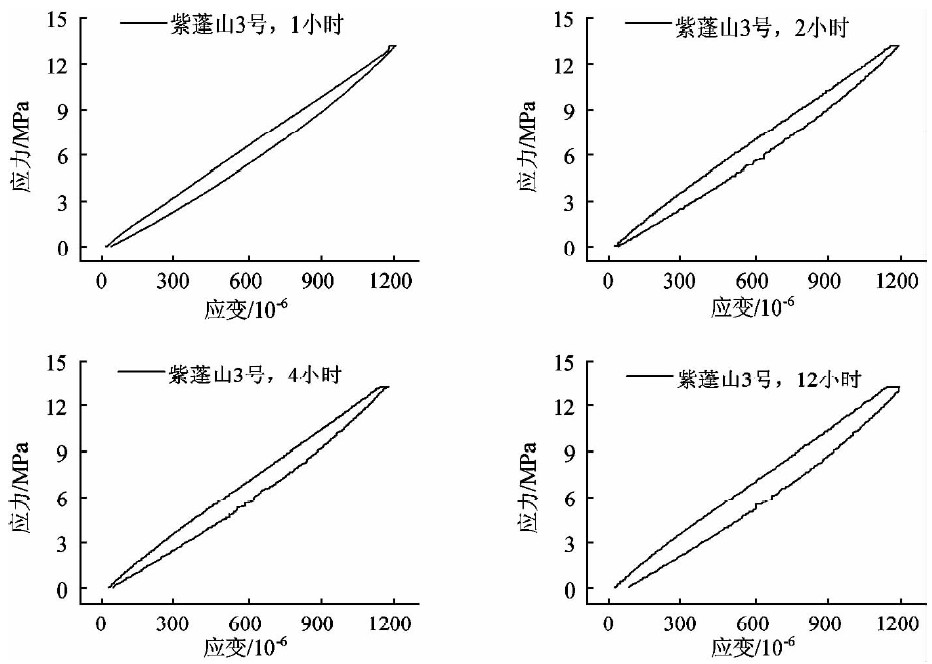 | 图 1 3号紫蓬山砂岩应力-应变图,1~12小时 Fig. 1 The stress-strain curves of No.3 sandstone,1~12 hours |
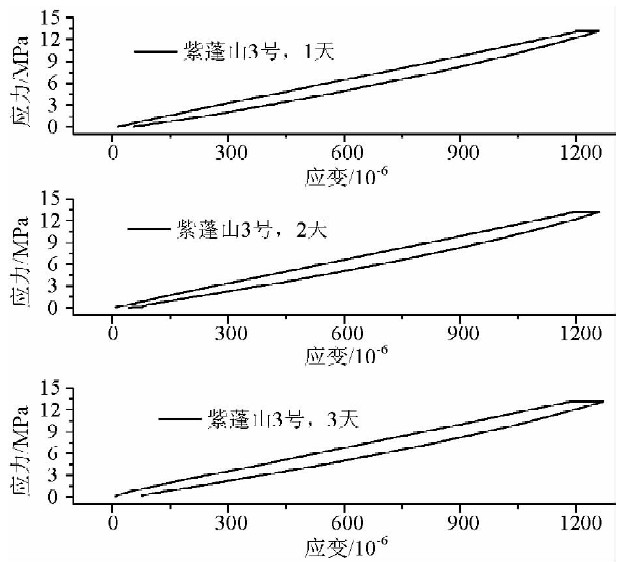 | 图 2 3号紫蓬山砂岩应力-应变图,1~3天 Fig. 2 The stress-strain curves of No.3 sandstone,1~3 days |
|
|
表 2 3号紫蓬山砂岩蠕变实验数据表(13.2 MPa) Table 2 The creep test data of No.3 sandstone(13.2 MPa) |
其他样品应力-应变曲线与此类似不再详细列出,仅由图 3、表 3给出最终结果,各样品蠕变实验计算结果表明Q有随蠕变周期增大而减小的直观规律.
 | 图 3 Q与蠕变周期关系图 Fig. 3 The relationship between Q and creep cycle |
|
|
表 3 蠕变实验下Q值总表 Table 3 Q of the creep tests |
为了论证实验结果的可靠,误差分析必不可少.每次实验采取了温度补偿应变片以及开启空调保持实验温度恒定, 3天实验的温差在2 ℃以内,同时每次实验前对样品进行了预压,实验后都放置2~3天以使上次实验积累在岩石中应力充分释放,尽量保证每次实验前岩石处于近似相同的应力状态.因为每次使用数字应变仪平衡电桥时都会有一个基线值,该值能够一定程度反映岩石应力状态,每次实验前纪录
基线值使实验在近似相同的应变仪基线上开始实验,尽量消除岩石状态不同给实验带来的误差.通过以上措施在尽量避免了温度和岩石内部应力造成的影响下(这一点可以从蠕变保持开始对应的应变值相差不大看出)实验误差多来自设备误差,±1个微应变对Q值造成的误差在100个数据点时为3%,±2 N压力误差与此相比可以忽略,蠕变实验数据点比100个要多很多,为了使实验结果令人信服取3%的实验误差.取表 3每块样品相邻的Q值相对差百分比,以4号砂岩为例,1天时间Q1d=37.63,2天时间Q2d=30.45,用ΔQ%=(Q1d-Q2d)/Q2d×100表示Q值的相对差百分比可以计算出为23.58%高于3%,用1小时和72小时的Q按上式计算得最大百分比.
表 4列出各样品Q值的相对差百分比、平均差百分比与最大差百分比:
|
|
表 4 Q值相对差百分比 Table 4 The percentage of relative difference of Q-values |
由表 4可以看出相邻两个周期下的平均相对差均大于3%,有8%左右的增幅,Q最大增幅对于大庆砂岩为45%左右,紫蓬山砂岩60%左右.蠕变实验下,Q值随作用周期的变化是明显的.
同样以紫蓬山3号砂岩为例,对样品和相应标准铝块的波形频谱分析后,再对各频率下相应的振幅比取对数并拟合可得图 4.
将拟合斜率γ、超声波在样品中的走时Δt,代入Q=πΔt/γ,求得衰减.同样的处理方法用于其他样品,所得结果由表 5给出.
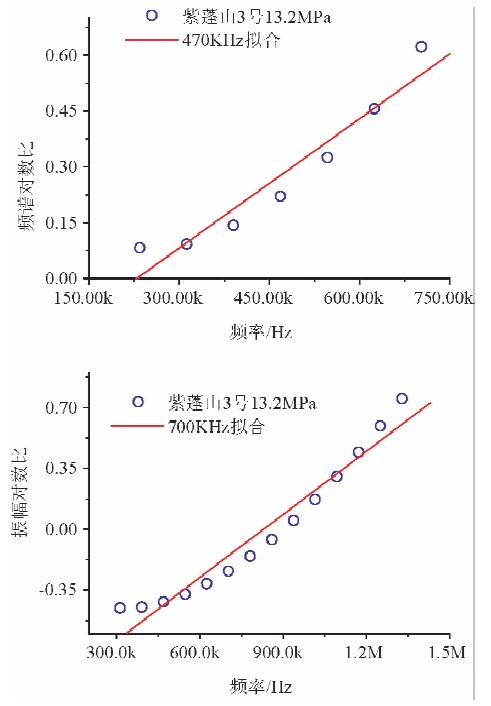 | 图 4 3号紫蓬山砂岩频谱振幅比 Fig. 4 The ratios of spectrum-amplitudes of No.3 sandstone |
|
|
表 5 超声波实验结果 Table 5 Experimental results of ultrasonic frequency |
由表 5数据可以看出Q值随频率变化很小(3%),超声波测量易受信号放大倍数、藕合、隐伏效应、频段选取等因素的影响,与应力-应变循环法相比误差较大,3%的误差可以认为超声波频率下衰减值不变,这和0.1~1 MHz内衰减近似为常数符合.与相同应力下蠕变Q值相比,超声波所得Q要大.
超声波频率下Q对蠕变周期下测得的Q值相对差最小在40%左右,最大相对差都在120%(如3号、4号、18号砂岩)左右.两者之间的差异除了由不同测量方法所致以外(Tang, 1992),还可以从应变量的角度考虑,并可以进行修正,下面将对这个问题进行具体分析,并解释衰减随应力作用频率的变化规律.
由2.1、2.2可得蠕变、超声波频率下的衰减,如图 5所示.
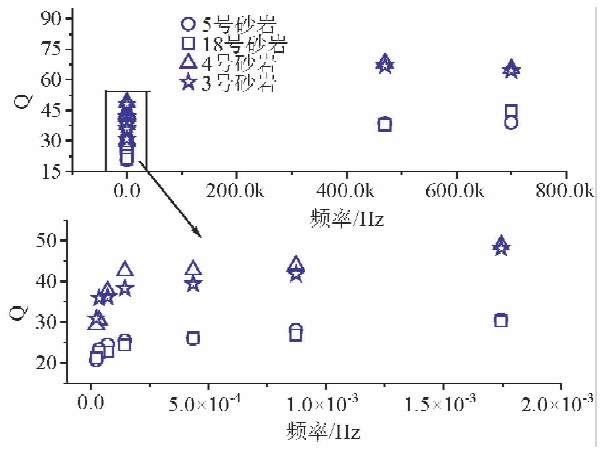 | 图 5 Q值与频率关系图 Fig. 5 The relationship between Q and frequency |
由图 5可以看出,Q值有随频率增大而增大的直观规律.但从何种角度解释这个问题?为什么两种方法测出来的Q值会有差异,造成这种差异的原因是什么?同时频率越大Q值也不可能一直增大,频率越小Q值也不可能一直减小,极限值是多少?
解决这些问题的关键在于蠕变量,下面将对此详细说明.
因为衰减与应力加载振幅和周期有关,相同应力加载振幅下的衰减比较起来才有意义,这就是本文考虑蠕变和超声波的衰减的原因.扣除了应力振幅因素,Q值与周期有关,蠕变周期与Q有一一对应的关系;如果从蠕变量角度来考虑,蠕变周期和蠕变量也是一一对应关系,将Q值与周期的关系转换为Q值与蠕变量的关系那么上面所有问题都能够解答.图 6是各样品衰减(Q-1)与蠕变量之间关系,大致可以看出蠕变量与衰减成线性关系,对这种关系进行拟合,拟合参数见表 6.
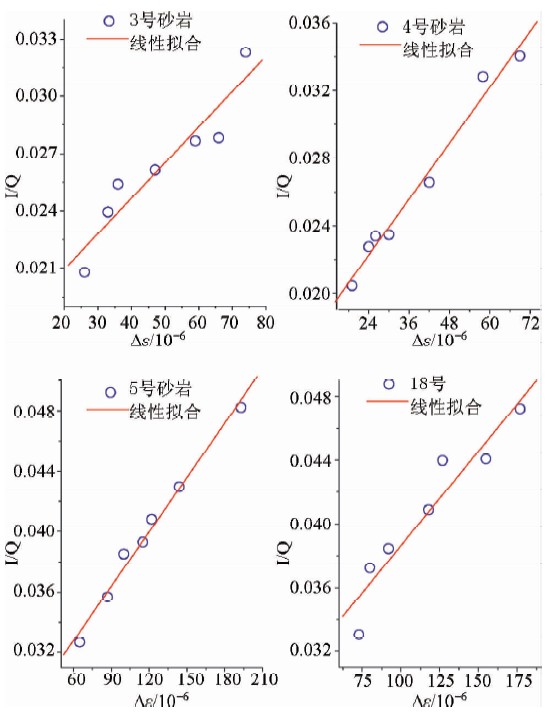 | 图 6 蠕变衰减与蠕变量关系图 Fig. 6 The relationship between attenuation and strain |
|
|
表 6 蠕变衰减拟合外推与超声波实测值比较 Table 6 The comparison of extrapolated attenuation and measured value |
由表 6可以看出,各拟合公式的截距对应的是零蠕变量的衰减,为了比较, 表中将衰减转化为Q即, 超声波或地震
波通过岩石产生的应变量很小几乎为零(包雪阳等,2005; 陈颙等,2009),其衰减对应于截距值,即其衰减值应该为,与超声波的实测值相比可以看到蠕变实验根据蠕变量外推得到的超声波衰减值跟实测值很相近,4号、5号样品几乎相同.这种蠕变量(应变量)与衰减的关系还可以说明为什么0.1~1 MHz频率内Q几乎为常数,因为这个频率内主要是通过波的传播特性来测量衰减,给样品造成的应变量都很小几乎为零,所以都接近拟合公式的截距.对这种关系朝蠕变量大的方向外推如果可以被实验证实,就能得衰减的最大值,只要估算岩石蠕变破裂前的应变量就可以知道这块样品的最大衰减.也能够得到同一块样品从蠕变破裂的极小频率到MHz量级频率内衰减关系.
扣除应力振幅对衰减的影响后,用应力-应变曲线法测了长周期蠕变实验的衰减,用频谱振幅比法测了短周期超声波实验的衰减,对两种结果进行了分析.
同种方法测得结果很有规律,两种方法测得的衰减却有明显差异,最小相对误差在40%左右,最大为120%,不同测量方法结果进行比较必然存在误差(陈颙等,2009),就本文两种方法结果而言,由于扣除了应力振幅因素(温丹等,2004),造成这种误差的原因是应力作用周期不同导致的,但从蠕变量角度对这种差异进行分析之后发现两种结果是很符合的.蠕变实验衰减结果表明衰减与蠕变量近似为线性关系,对这种关系进行线性拟合后发现蠕变量为零时截距处的衰减值与超声波实验测得的衰减值很接近,表明这种关系可以朝小应变方向外推,也解释了为什么在0.1~1 MHz频率内衰减近似为常数的规律,因为该频率内测衰减方法主要是用波传播法,应变量都很小所以都接近于截距值.该关系是否可以向大蠕变量方向外推,还需要实验验证,如果这种关系还成立就可以得到样品衰减极大值.
应变量与衰减的这种关系在实际勘测中也有参考意义,地下岩石是长时间处于蠕变状态,地震波测的衰减跟真实情况下的衰减是否有差异,两者之间需不需要修正如何修正,有待于进一步研究.
致 谢 感谢姜会存师傅在实验样品加工中给予的帮助,感谢李峰博士对本文的有益讨论.
| [1] | Ba J, Carcione J M, Cao H, et al. 2012. Velocity dispersion and attenuation of P waves in partially-saturated rocks: Wave propagation equations in double-porosity medium[J]. Chinese J. Geophys. (in Chinese), 55(1): 219-231. doi:10.6038/j.issn.0001-5733.2012.01.021. |
| [2] | Bai H, Li K P. 1999. Stratigraphic absorption compensation based on time-frequency analysis[J]. OGP (in Chinese), 34(6): 642-648. doi: 10.3321/j.issn:1000-7210.1999.06.005. |
| [3] | Bao X Y, Shi X J. 2005. Experiment study and interpretation on relation between modulus of rocks and strain amplitudes[J]. Earthquake Research in China (in Chinese), 21(4): 508-518. doi:10.3969/j.issn.1001-4683.2005.04.007. |
| [4] | Birch F, Banctoft D. 1938. Elasticity and internal friction in a long column of granite[J]. Bull.SSA, 28(4): 243-254. |
| [5] | Born W T. 1941. The attenuation constant of earth materials[J]. Geophysics, 6(2): 132-148. doi:10.1190/1.1443714. |
| [6] | Bourbie T, Coussy O, Zinzner B. 1987. Acoustic of porous media[M]. Houston: Gulf Publishing. |
| [7] | Chen Y, Huang T F. 2001. Rock Physics (in Chinese) [M]. Beijing: Peking University Press. |
| [8] | Chen Y, Huang T F, Liu E R. 2009. Rock Physics (in Chinese) [M]. Hefei: University of Science and Technology of China Press. |
| [9] | Dunn K J. 1987. Sample boundary effect in acoustic attenuation of fluid-saturated porous cylinders[J]. J. Acoust. Sot. Am., 81(5), 1259-1266, doi:10.1121/1.394529 01.004. |
| [10] | Gao J H, Yang S L. 2007. On the method of quality factors estimation from zero-offset VSP data[J]. Chinese J. Geophys. (in Chinese), 50(4): 1198-1209. doi:10.3321/j.issn:0001-5733.2007.04.029. |
| [11] | Gardner G H F, Wyllie M R J, Droschak D M. 1964. Effects of pressure and fluid saturation on the attenuation of elastic waves in sands[J]. J. Petrol. Tech., 16(2): 189-198. doi:10.2118/721-PA. |
| [12] | Huffman A R, Castagna J P. 2001. The petrophysical basis for shallow-water flow prediction using multi-component seismic data[J]. The Leading Edge, 20(9): 1030-1036. doi:10.1190/1.1487308. |
| [13] | Jackson D D. 1969. Grain Boundary Relaxation and the Attenuation of Seismic Waves [Ph. D. thesis]. Cambridge: M. I. T. |
| [14] | Kuster G T, ToksBz M N. 1974. Velocity and attenuation of seismic waves in two-phase media: Part II-Experimental results[J]. Geophysics, 39(5): 607-618. doi:10.1121/1.387843. |
| [15] | Liu Z B, Hao Z B, Wu X Y. 2008. Shallow water flow hazard: a challenge in deepwater drilling[J]. Progress in Geophysics (in Chinese), 23(2): 552-558. |
| [16] | Lucet N, Rasolofosaon N J P, Zinszner B. 1991. Sonic properties of rocks under confining pressure using the resonant bar technique[J]. J. Acoust. Sot. Am., 89(3), 98-990. doi: 10.1121/1.400643. |
| [17] | Ma Z J, Liu Y. 2005. A summary of research on seismic attenuation[J]. Chinese J. Geophys. (in Chinese), 20(4): 1074-1082. |
| [18] | Murphy W F. 1982. Effects of partial water saturation on attenuation in massilon sandstone and vycor porous glass [J]. J. Acoust. Soc Am., 71(6): 1458-1468. doi:10.1121/1.387843. |
| [19] | Paffenholz J, Burkhardt H. 1989. Absorption and modulus measurements in the seismic frequency and strain range on partially saturated sedimentary rocks[J]. J. Geophys. Res., 94(B7): 9493-9507. doi:10.1029/JB094iB07p09493. |
| [20] | Peselnick L, Zietz I. 1959. Internal friction of fine erained limestones at ultrasonic-frequencies[J]. Geophysics, 24(2): 285-296. doi:10.1190/1.1438583. |
| [21] | Prasad M. 2002. Acoustic measurements in unconsolidated sands at low effective pressure and overpressure detection[J]. Geophysics, 67(2): 405-412. doi:10.1190/1.1468600. |
| [22] | Spencer J W. 1981. Stress relaxations at low frequencies in fluid-saturated rocks: attenuation and modulus dispersion[J]. J. Geophys. Res., 86(B3), 1803-1812. doi:10.1029/JB086iB03p01803. |
| [23] | Spetzler H, Anderson D L. 1968. The effect of temperature and partial melting on velocity and attenuation in a simple binary system[J]. J. Geophys. Res., 73(18): 6051-6060. doi:10.1029/JB073i018p06051. |
| [24] | Su Y D, Zhuang C X, Tang X M. 2012. LWD acoustic color mode wave attenuation character research and isolator design[J]. Chinese J. Geophys. (in Chinese), 54(9): 2419-2428. doi:10.3969/j.issn.0001-5733.2011.09.026. |
| [25] | Sun L, Li Y H, Wu Q J, et al. 2012. Q0 tomography of S wave attenuation in Northeast China and adjacent regions[J]. Chinese J. Geophys. (in Chinese), 55(4): 1179-1185. doi:10.6038/j.issn.0001-5733.2012.04.014. |
| [26] | Tang X M. 1992. A waveform inversion technique for measuring elastic wave attenuation in cylindrical bars[J]. Geophysics, 57(6): 854-859. doi:10.1190/1.1443299. |
| [27] | Toksoz M N, Johnston D H, Timur A. 1979. Attenuation of seismic waves in dry and saturated rocks: I. Laboratory measurements[J]. Geophysics, 44(4): 681-690. doi:10.1190/1.1440451. |
| [28] | Wen D, Shi X J. 2004. A study on the relationship between attenuation and strain amplitude in rock using endochronic theory[J]. Journal of Experimental Mechanics (in Chinese), 19(1): 19-23. doi:10.3969/j.issn.1001-4888.2004. |
| [29] | Winkler K, Nur A. 1979. The effects of pore fluids and frictional sliding on seismic attenuation[Ph. D. thesis]. Stanford: Stanford Univ. |
| [30] | Winkler K, Nur A. 1982. Seismic attenuation: Effects of pore fluids and frictional sliding[J]. Geophysics, 47(1): 1-15. doi:10.1190/1.1441276. |
| [31] | Winkler K W. 1986. Estimates of velocity dispersion between seismic and ultrasonic frequencies[J]. Geophysics, 51(1), 183-189. doi:10.1190/1.1442031. |
| [32] | Wu Y T, Zhu G M, Liu Y K, et al. 2011. Research and modification of VSP attenuation characteristics based on Ganley's forward theory[J]. Chinese J. Geophys. (in Chinese), 54(9): 2368-2374. doi:10.3969/j.issn.0001-5733.2011.09.020. |
| [33] | Xu Y, Su Y J, Qin J Z. 2004. Development of Q-value studies [J]. Journal of Seismological Research (in Chinese), 27(4): 385-389 doi:10.3969/j.issn.1000-0666.2004.04.019 |
| [34] | Zhang G L. 2011. Low-frequency absorption attenuation gradient detection based on improved generalized S transform[J]. Chinese J. Geophys. (in Chinese), 54(9): 2407-2411. doi:10.3969/j.issn.0001-5733.2011.09.024. |
| [35] | Zhu Z Y, Wang D, Zhou J P, et al. 2012. Acoustic wave dispersion and attenuation in marine sediment based on partially gas-saturated Biot-Stoll model[J]. Chinese J. Geophys. (in Chinese), 55(1): 180-188. doi:10.6038/j.issn.0001-5733.2012.01.017. |
| [36] | 巴晶, Carcione J M, 曹宏,等. 2012. 非饱和岩石中的纵波频散与衰减: 双重孔隙介质波传播方程[J]. 地球物理学报, 55(1): 219-231. doi:10.6038/j.issn.0001-5733.2012.01.021. |
| [37] | 白桦, 李鲲鹏. 1999. 基于时频分析的地层吸收补偿[J]. 石油地球物理勘探, 34(6): 642-648. doi:10.3321/j.issn:1000-7210.1999.06.005. |
| [38] | 包雪阳, 施行觉, 温丹,等. 2005. 岩石模量与应变振幅关系的实验研究及理论解释[J]. 中国地震, 21(4), 508-518. doi:10.3969/j.issn.1001-4683.2005.04.007. |
| [39] | 陈颙, 黄庭芳. 2001. 岩石物理学[M]. 北京: 北京大学出版社. |
| [40] | 陈颙, 黄庭芳, 刘恩儒. 2009. 岩石物理学[M]. 合肥: 中国科学技术大学出版社. |
| [41] | 高静怀, 杨森林. 2007. 利用零偏移VSP资料估计介质品质因子方法研究[J]. 地球物理学报, 50(4): 1198-1209. doi:10.3321/j.issn:0001-5733.2007.04.029. |
| [42] | 刘志斌, 郝召兵, 伍向阳. 2008. 深水钻探面临的挑战浅水流灾害问题[J]. 地球物理学进展, 23(2): 552-558. |
| [43] | 马昭军, 刘洋. 2005. 地震波衰减反演研究综述[J]. 地球物理学进展, 20(4): 1074-1082. |
| [44] | 苏远大, 庄春喜, 唐晓明. 2012. 随钻声波测井钻铤模式波衰减规律研究与隔声体设计[J]. 地球物理学报, 54(9): 2419-2428. doi:10.3969/j.issn.0001-5733.2011.09.026. |
| [45] | 孙莲, 李永华, 吴庆举,等. 2012. 中国东北及周边地区地壳横波衰减的成像研究[J]. 地球物理学报, 55(4): 1179-1185, doi:10.6038/j.issn.0001-5733.2012.04.014. |
| [46] | 温丹, 施行觉. 2004. 结合内时理论研究岩石衰减与应变振幅的关系[J]. 实验力学, 19(1): 19-23. doi:10.3969/j.issn.1001-4888.2004.01.004. |
| [47] | 武银婷, 朱光明, 刘伊克,等. 2011. 基于Ganley理论含有衰减特性零偏VSP正演研究及修正[J]. 地球物理学报, 54(9): 2368-2374. doi:10.3969/j.issn.0001-5733.2011.09.020. |
| [48] | 徐彦, 苏有锦, 秦嘉政. 2004. Q值研究动态[J]. 地震研究, 27(4): 385-389. doi:10.3969/j.issn.1000-0666.2004.04.019. |
| [49] | 张固澜. 2011. 基于改进的广义S变换的低频吸收衰减梯度检测[J]. 地球物理学报, 54(9): 2407-2411. doi:10.3969/j.issn.0001-5733.2011.09.024. |
| [50] | 朱祖扬, 王东, 周建平,等. 2012. 基于非饱和Biot-Stoll模型的海底沉积物介质声频散特性研究[J]. 地球物理学报, 55(1): 180-188. doi:10.6038/j.issn.0001-5733.2012.01.017. |
 2014, Vol. 29
2014, Vol. 29

